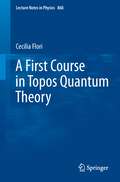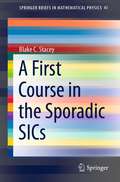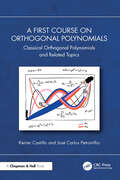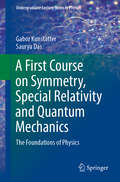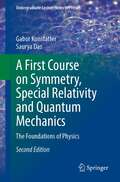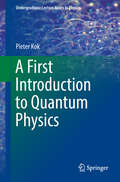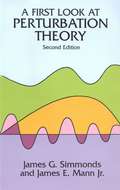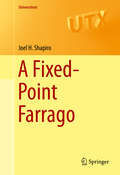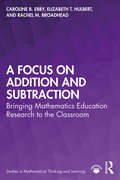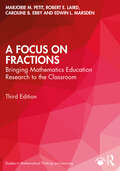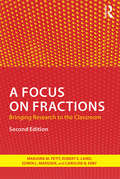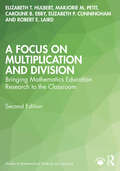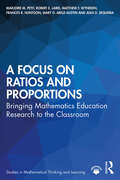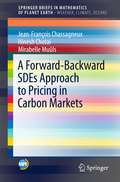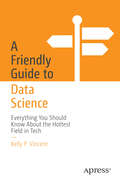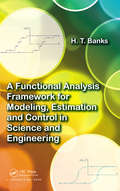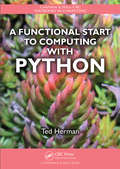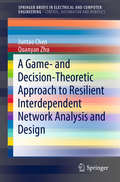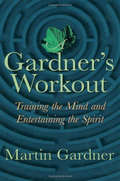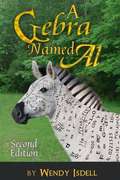- Table View
- List View
A First Course in Topos Quantum Theory (Lecture Notes in Physics #868)
by Cecilia FloriIn the last five decades various attempts to formulate theories of quantum gravity have been made, but none has fully succeeded in becoming the quantum theory of gravity. One possible explanation for this failure might be the unresolved fundamental issues in quantum theory as it stands now. Indeed, most approaches to quantum gravity adopt standard quantum theory as their starting point, with the hope that the theory's unresolved issues will get solved along the way. However, these fundamental issues may need to be solved before attempting to define a quantum theory of gravity. The present text adopts this point of view, addressing the following basic questions: What are the main conceptual issues in quantum theory? How can these issues be solved within a new theoretical framework of quantum theory? A possible way to overcome critical issues in present-day quantum physics - such as a priori assumptions about space and time that are not compatible with a theory of quantum gravity, and the impossibility of talking about systems without reference to an external observer - is through a reformulation of quantum theory in terms of a different mathematical framework called topos theory. This course-tested primer sets out to explain to graduate students and newcomers to the field alike, the reasons for choosing topos theory to resolve the above-mentioned issues and how it brings quantum physics back to looking more like a "neo-realist" classical physics theory again.
A First Course in Wavelets with Fourier Analysis
by Francis J. Narcowich Albert BoggessA comprehensive, self-contained treatment of Fourier analysis and wavelets--now in a new editionThrough expansive coverage and easy-to-follow explanations, A First Course in Wavelets with Fourier Analysis, Second Edition provides a self-contained mathematical treatment of Fourier analysis and wavelets, while uniquely presenting signal analysis applications and problems. Essential and fundamental ideas are presented in an effort to make the book accessible to a broad audience, and, in addition, their applications to signal processing are kept at an elementary level.The book begins with an introduction to vector spaces, inner product spaces, and other preliminary topics in analysis. Subsequent chapters feature:The development of a Fourier series, Fourier transform, and discrete Fourier analysisImproved sections devoted to continuous wavelets and two-dimensional waveletsThe analysis of Haar, Shannon, and linear spline waveletsThe general theory of multi-resolution analysisUpdated MATLAB code and expanded applications to signal processingThe construction, smoothness, and computation of Daubechies' waveletsAdvanced topics such as wavelets in higher dimensions, decomposition and reconstruction, and wavelet transformApplications to signal processing are provided throughout the book, most involving the filtering and compression of signals from audio or video. Some of these applications are presented first in the context of Fourier analysis and are later explored in the chapters on wavelets. New exercises introduce additional applications, and complete proofs accompany the discussion of each presented theory. Extensive appendices outline more advanced proofs and partial solutions to exercises as well as updated MATLAB routines that supplement the presented examples.A First Course in Wavelets with Fourier Analysis, Second Edition is an excellent book for courses in mathematics and engineering at the upper-undergraduate and graduate levels. It is also a valuable resource for mathematicians, signal processing engineers, and scientists who wish to learn about wavelet theory and Fourier analysis on an elementary level.
A First Course in the Design of Experiments: A Linear Models Approach
by John H. SkillingsMost texts on experimental design fall into one of two distinct categories. There are theoretical works with few applications and minimal discussion on design, and there are methods books with limited or no discussion of the underlying theory. Furthermore, most of these tend to either treat the analysis of each design separately with little attempt to unify procedures, or they will integrate the analysis for the designs into one general technique.A First Course in the Design of Experiments: A Linear Models Approach stands apart. It presents theory and methods, emphasizes both the design selection for an experiment and the analysis of data, and integrates the analysis for the various designs with the general theory for linear models. The authors begin with a general introduction then lead students through the theoretical results, the various design models, and the analytical concepts that will enable them to analyze virtually any design. Rife with examples and exercises, the text also encourages using computers to analyze data. The authors use the SAS software package throughout the book, but also demonstrate how any regression program can be used for analysis.With its balanced presentation of theory, methods, and applications and its highly readable style, A First Course in the Design of Experiments proves ideal as a text for a beginning graduate or upper-level undergraduate course in the design and analysis of experiments.
A First Course in the Numerical Analysis of Differential Equations
by Arieh IserlesNumerical analysis presents different faces to the world. For mathematicians it is a bona fide mathematical theory with an applicable flavour. For scientists and engineers it is a practical, applied subject, part of the standard repertoire of modelling techniques. For computer scientists it is a theory on the interplay of computer architecture and algorithms for real-number calculations. The tension between these standpoints is the driving force of this book, which presents a rigorous account of the fundamentals of numerical analysis of both ordinary and partial differential equations. The point of departure is mathematical but the exposition strives to maintain a balance between theoretical, algorithmic and applied aspects of the subject. In detail, topics covered include numerical solution of ordinary differential equations by multistep and Runge-Kutta methods; finite difference and finite elements techniques for the Poisson equation; a variety of algorithms to solve large, sparse algebraic systems; methods for parabolic and hyperbolic differential equations and techniques of their analysis. The book is accompanied by an appendix that presents brief back-up in a number of mathematical topics. Dr Iserles concentrates on fundamentals: deriving methods from first principles, analysing them with a variety of mathematical techniques and occasionally discussing questions of implementation and applications. By doing so, he is able to lead the reader to theoretical understanding of the subject without neglecting its practical aspects. The outcome is a textbook that is mathematically honest and rigorous and provides its target audience with a wide range of skills in both ordinary and partial differential equations.
A First Course in the Sporadic SICs (SpringerBriefs in Mathematical Physics #41)
by Blake C. StaceyThis book focuses on the Symmetric Informationally Complete quantum measurements (SICs) in dimensions 2 and 3, along with one set of SICs in dimension 8. These objects stand out in ways that have earned them the moniker of "sporadic SICs". By some standards, they are more approachable than the other known SICs, while by others they are simply atypical. The author forays into quantum information theory using them as examples, and the author explores their connections with other exceptional objects like the Leech lattice and integral octonions. The sporadic SICs take readers from the classification of finite simple groups to Bell's theorem and the discovery that "hidden variables" cannot explain away quantum uncertainty.While no one department teaches every subject to which the sporadic SICs pertain, the topic is approachable without too much background knowledge. The book includes exercises suitable for an elective at the graduate or advanced undergraduate level.
A First Course on Orthogonal Polynomials: Classical Orthogonal Polynomials and Related Topics
by Kenier Castillo José Carlos PetronilhoA First Course on Orthogonal Polynomials: Classical Orthogonal Polynomials and Related Topics provides an introduction to orthogonal polynomials and special functions aimed at graduate students studying these topics for the first time. A large part of its content is essentially inspired by the works of Pascal Maroni on the so-called algebraic theory of orthogonal polynomials, which distinguishes it from other contributions in the field.Features Suitable for a graduate course in orthogonal polynomials Can be used for a short course on the algebraic theory of orthogonal polynomials and its applicability to the study of the “old” classical orthogonal polynomials Includes numerous exercises for each topic Real and complex analysis are the only prerequisites
A First Course on Symmetry, Special Relativity and Quantum Mechanics: The Foundations of Physics (Undergraduate Lecture Notes in Physics)
by Gabor Kunstatter Saurya DasThis book provides an in-depth and accessible description of special relativity and quantum mechanics which together form the foundation of 21st century physics. A novel aspect is that symmetry is given its rightful prominence as an integral part of this foundation. The book offers not only a conceptual understanding of symmetry, but also the mathematical tools necessary for quantitative analysis. As such, it provides a valuable precursor to more focused, advanced books on special relativity or quantum mechanics.Students are introduced to several topics not typically covered until much later in their education.These include space-time diagrams, the action principle, a proof of Noether's theorem, Lorentz vectors and tensors, symmetry breaking and general relativity. The book also provides extensive descriptions on topics of current general interest such as gravitational waves, cosmology, Bell's theorem, entanglement and quantum computing.Throughout the text, every opportunity is taken to emphasize the intimate connection between physics, symmetry and mathematics.The style remains light despite the rigorous and intensive content. The book is intended as a stand-alone or supplementary physics text for a one or two semester course for students who have completed an introductory calculus course and a first-year physics course that includes Newtonian mechanics and some electrostatics. Basic knowledge of linear algebra is useful but not essential, as all requisite mathematical background is provided either in the body of the text or in the Appendices. Interspersed through the text are well over a hundred worked examples and unsolved exercises for the student.
A First Course on Symmetry, Special Relativity and Quantum Mechanics: The Foundations of Physics (Undergraduate Lecture Notes in Physics)
by Gabor Kunstatter Saurya DasThis book provides an in-depth and accessible description of special relativity and quantum mechanics which together form the foundation of 21st century physics. A novel aspect is that symmetry is given its rightful prominence as an integral part of this foundation. The book offers not only a conceptual understanding of symmetry, but also the mathematical tools necessary for quantitative analysis. As such, it provides a valuable precursor to more focused, advanced books on special relativity or quantum mechanics.Students are introduced to several topics not typically covered until much later in their education.These include space-time diagrams, the action principle, a proof of Noether's theorem, Lorentz vectors and tensors, symmetry breaking and general relativity. The book also provides extensive descriptions on topics of current general interest such as gravitational waves, cosmology, Bell's theorem, entanglement and quantum computing.Throughout the text, every opportunity is taken to emphasize the intimate connection between physics, symmetry and mathematics.The style remains light despite the rigorous and intensive content. The book is intended as a stand-alone or supplementary physics text for a one or two semester course for students who have completed an introductory calculus course and a first-year physics course that includes Newtonian mechanics and some electrostatics. Basic knowledge of linear algebra is useful but not essential, as all requisite mathematical background is provided either in the body of the text or in the Appendices. Interspersed through the text are well over a hundred worked examples and unsolved exercises for the student.
A First Graduate Course in Abstract Algebra (Pure and Applied Mathematics #266)
by W. J. Wickless<p>Since abstract algebra is so important to the study of advanced mathematics, it is critical that students have a firm grasp of its principles and underlying theories before moving on to further study. To accomplish this, they require a concise, accessible, user-friendly textbook that is both challenging and stimulating. A First Graduate Course in Abstract Algebra is just such a textbook. <p>Divided into two sections, this book covers both the standard topics (groups, modules, rings, and vector spaces) associated with abstract algebra and more advanced topics such as Galois fields, noncommutative rings, group extensions, and Abelian groups. The author includes review material where needed instead of in a single chapter, giving convenient access with minimal page turning. He also provides ample examples, exercises, and problem sets to reinforce the material. <p>This book illustrates the theory of finitely generated modules over principal ideal domains, discusses tensor products, and demonstrates the development of determinants. It also covers Sylow theory and Jordan canonical form.A First Graduate Course in Abstract Algebra is ideal for a two-semester course, providing enough examples, problems, and exercises for a deep understanding. Each of the final three chapters is logically independent and can be covered in any order, perfect for a customized syllabus.</p>
A First Introduction to Quantum Physics (Undergraduate Lecture Notes in Physics)
by Pieter KokIn this undergraduate textbook, the author develops the quantum theory from first principles based on very simple experiments: a photon travelling through beam splitters to detectors, an electron moving through a Stern-Gerlach machine, and an atom emitting radiation. From the physical description of these experiments follows a natural mathematical description in terms of matrices and complex numbers. The first part of the book examines how experimental facts force us to let go of some deeply held preconceptions and develops this idea into a mathematical description of states, probabilities, observables, and time evolution using physical applications. The second part of the book explores more advanced topics, including the concept of entanglement, the process of decoherence, and extension of the quantum theory to the situation of a particle in a one-dimensional box. Here, the text makes contact with more traditional treatments of quantum mechanics. The remaining chapters delve deeply into the idea of uncertainty relations and explore what the quantum theory says about the nature of reality. The book is an ideal and accessible introduction to quantum physics, with modern examples and helpful end-of-chapter exercises.
A First Look at Perturbation Theory (Dover Books on Physics)
by James E. Mann Jr. James G. SimmondsUndergraduates in engineering and the physical sciences receive a thorough introduction to perturbation theory in this useful and accessible text. Students discover methods for obtaining an approximate solution of a mathematical problem by exploiting the presence of a small, dimensionless parameter -- the smaller the parameter, the more accurate the approximate solution. Knowledge of perturbation theory offers a twofold benefit: approximate solutions often reveal the exact solution's essential dependence on specified parameters; also, some problems resistant to numerical solutions may yield to perturbation methods. In fact, numerical and perturbation methods can be combined in a complementary way.The text opens with a well-defined treatment of finding the roots of polynomials whose coefficients contain a small parameter. Proceeding to differential equations, the authors explain many techniques for handling perturbations that reorder the equations or involve an unbounded independent variable. Two disparate practical problems that can be solved efficiently with perturbation methods conclude the volume.Written in an informal style that moves from specific examples to general principles, this elementary text emphasizes the "why" along with the "how"; prerequisites include a knowledge of one-variable calculus and ordinary differential equations. This newly revised second edition features an additional appendix concerning the approximate evaluation of integrals.
A Fixed-Point Farrago (Universitext)
by Joel H. ShapiroThis text provides an introduction to some of the best-known fixed-point theorems, with an emphasis on their interactions with topics in analysis. The level of exposition increases gradually throughout the book, building from a basic requirement of undergraduate proficiency to graduate-level sophistication. Appendices provide an introduction to (or refresher on) some of the prerequisite material and exercises are integrated into the text, contributing to the volume's ability to be used as a self-contained text. Readers will find the presentation especially useful for independent study or as a supplement to a graduate course in fixed-point theory. The material is split into four parts: the first introduces the Banach Contraction-Mapping Principle and the Brouwer Fixed-Point Theorem, along with a selection of interesting applications; the second focuses on Brouwer's theorem and its application to John Nash's work; the third applies Brouwer's theorem to spaces of infinite dimension; and the fourth rests on the work of Markov, Kakutani, and Ryll-Nardzewski surrounding fixed points for families of affine maps.
A Focus on Addition and Subtraction: Bringing Mathematics Education Research to the Classroom (Studies in Mathematical Thinking and Learning Series)
by Elizabeth T. Hulbert Caroline B. Ebby Rachel M. BroadheadThis innovative text offers a unique approach to making mathematics education research on addition, subtraction, and number concepts readily accessible and understandable to pre-service and in-service teachers of grades K–3. Revealing students’ thought processes with extensive annotated samples of student work and vignettes characteristic of teachers’ experiences, this book provides educators with the knowledge and tools needed to modify their lessons and improve student learning of additive reasoning in the primary grades. Based on research gathered in the Ongoing Assessment Project (OGAP), this engaging, easy-to-use resource features practical resources such as: A close focus on student work, including 150+ annotated pieces of student work, to help teachers improve their ability to recognize, assess, and monitor their students’ errors and misconceptions, as well as their developing conceptual understanding; A focus on the OGAP Addition, Subtraction, and Base Ten Number Progressions, based on research conducted with hundreds of teachers and thousands of pieces of student work; In-chapter sections on how Common Core State Standards for Math (CCSSM) are supported by math education research; End-of-chapter questions to allow teachers to analyze student thinking and consider instructional strategies for their own students; Instructional links to help teachers relate concepts from each chapter to their own instructional materials and programs; An accompanying eResource, available online, offers an answer key to Looking Back questions, as well as a copy of the OGAP Additive Framework and the OGAP Number Line Continuum. A Focus on Addition and Subtraction marks the fourth installment of the popular A Focus on… collection, designed to aid the professional development of pre-service and in-service mathematics teachers. Following from previous volumes on ratios and proportions, multiplication and division, and fractions, this newest addition is designed to bridge the gap between what math education researchers know and what teachers need to know in order to better understand evidence in student work and make effective instructional decisions.
A Focus on Fractions: Bringing Mathematics Education Research to the Classroom (Studies in Mathematical Thinking and Learning Series)
by Marjorie M. Petit Caroline B. Ebby Robert E. Laird Edwin L. MarsdenThe third edition of this book offers a unique approach to making mathematics education research on the teaching and learning of fraction concepts readily accessible and understandable to pre-service and in-service K-8 mathematics teachers. Revealing students’ thought processes with extensive annotated samples of student work and vignettes characteristic of classroom teachers’ experience, this book provides teachers a research-based lens to interpret evidence of student thinking, inform instruction and ultimately improve student learning. Based on research gathered in the Ongoing Assessment Project (OGAP), and updated throughout, this engaging and easy-to-use resource also features: Two new chapters dedicated to understanding the OGAP Fraction Framework and Progression—based on research conducted with hundreds of teachers—to gather and interpret evidence of student learning along a learning progression, referenced throughout the book so readers can apply the concepts to their instruction; A close focus on student work, including 180+ annotated pieces of student work, to help teachers improve their ability to recognize, assess, and monitor their students’ errors and misconceptions, as well as their developing conceptual understanding; A discussion of decimal fractions, also new to the third edition; In-chapter sections on how Common Core State Standards for Math (CCSSM) are supported by math education research; End-of-chapter Looking Back questions to allow teachers to analyze student thinking and consider instructional strategies for their own students; Instructional links to help teachers relate concepts from each chapter to their own instructional materials and programs; Accompanying online Support Material includes an answer key to Looking Back questions, as well as a copy of the OGAP Fraction Framework and Progression. A Focus on Fractions is part of the popular A Focus on . . . collection, designed to aid the professional development of pre-service and in-service mathematics teachers. As with the other volumes on addition and subtraction, ratios and proportions, and multiplication and division, this updated new edition bridges the gap between what math education researchers know and what teachers need to know in order to better understand evidence in student work and make effective instructional decisions.
A Focus on Fractions: Bringing Research to the Classroom (Studies in Mathematical Thinking and Learning Series)
by Marjorie M. Petit Caroline B. Ebby Robert E. Laird Edwin L. MarsdenA Focus on Fractions is a groundbreaking effort to make the mathematics education research on how students develop their understanding of fraction concepts readily accessible and understandable to pre- and in-service K– 8 mathematics educators. Using extensive annotated samples of student work, as well as vignettes characteristic of classroom teachers’ experiences, this book equips educators with the knowledge and tools to reveal students’ thinking so that they can modify their teaching and improve student learning of fraction concepts. A Focus on Fractions 2nd edition includes sections on the Common Core State Standards for Mathematics and the Ongoing Assessment Project (OGAP) Fraction Framework integrated into each chapter as well as a new chapter on the OGAP Fraction Progression and how it can be used for formative assessment purposes. This updated edition assists teachers in translating research findings into their classroom practice by conveying detailed information about how students develop fraction understandings. Additional images and examples serve to flesh out and supplement the newly-introduced concepts in this updated and expanded edition. Special Features: Looking Back Questions at the end of each chapter provide teachers the opportunity to analyze student thinking and consider instructional strategies for their own students. Instructional Links help teachers relate concepts from the chapter to their own instructional materials and programs. Big Ideas frame the chapters and provide a platform for meaningful exploration of the teaching of fractions. Answer Key posted online offers extensive explanations of in-chapter questions. New sections devoted to the CCSSM and OGAP Fraction Progression are woven throughout the book as well as a new stand alone chapter on the OGAP Fraction Progression. The OGAP Fraction Framework is an all-new eResource, now available as a free download from the book’s website: www.routledge.com/9781138816442.
A Focus on Multiplication and Division: Bringing Mathematics Education Research to the Classroom (Studies in Mathematical Thinking and Learning Series)
by Elizabeth T. Hulbert Marjorie M. Petit Caroline B. Ebby Elizabeth P. Cunningham Robert E. LairdThe second edition of this book offers a unique approach to making mathematics education research on the teaching and learning of multiplication and division concepts readily accessible and understandable to preservice and in-service K-6 mathematics teachers. Revealing students’ thought processes with extensive annotated samples of student work and vignettes characteristic of classroom teachers’ experience, this book provides teachers a research-based lens to interpret evidence of student thinking, inform instruction, and ultimately improve student learning. Based on research gathered in the Ongoing Assessment Project (OGAP) and updated throughout, this engaging and easy-to-use resource also features the following: New chapters on the OGAP Multiplicative Reasoning Framework and Learning Progressions and Using the OGAP Multiplicative Progression to inform instruction and support student learning In-chapter sections on how Common Core State Standards for Math are supported by math education research Case Studies focusing on a core mathematical idea and different types of instructional responses to illustrate how teachers can elicit evidence of student thinking and use that information to inform instruction Big Ideas frame the chapters and provide a platform for meaningful exploration of the teaching of multiplication and division Looking Back Questions at the end of each chapter allow teachers to analyze student thinking and to consider instructional strategies for their own students Instructional Links to help teachers relate concepts from each chapter to their own instructional materials and programs Accompanying online Support Material that includes an answer key to Looking Back questions, as well as a copy of the OGAP Fraction Framework and Progression A Focus on Multiplication and Division is part of the popular A Focus on . . . collection, designed to aid the professional development of preservice and in-service mathematics teachers. As with the other volumes on addition and subtraction, ratios and proportions, and fractions, this updated new edition bridges the gap between what math education researchers know and what teachers need to know to better understand evidence in student work and make effective instructional decisions.
A Focus on Ratios and Proportions: Bringing Mathematics Education Research to the Classroom (Studies in Mathematical Thinking and Learning Series)
by Marjorie M. Petit Robert E. Laird Matthew F. Wyneken Frances R. Huntoon Mary D. Abele-Austin Jean D. SequeiraThis resource offers a groundbreaking effort to make mathematics education research on ratios and proportions readily accessible and understandable to preservice and in-service teachers of grades 6 to 8. Using extensive annotated samples of student work and based on research gathered in the Ongoing Assessment Project (OGAP), A Focus on Ratios and Proportions teaches readers how students develop understanding and fluency involving ratio and proportion concepts. Special features include: A close focus on student work, including 150+ annotated pieces of student work, to help teachers improve their ability to recognize, assess and monitor their students’ errors and misconceptions, as well as their developing conceptual understanding. A focus on the OGAP Ratios and Proportions Progression, based on research conducted with hundreds of teachers and thousands of pieces of student work. Sections on how Common Core State Standards for Math (CCSSM) are supported by math education research. Student work samples and vignettes to illuminate the research, as well as end of chapter Looking Back questions and Instructional Links, which allow teachers to analyze evidence of student thinking and strategies and consider instructional responses. An accompanying eResource, available online, offers an answer key as well as extensive explanation of the Looking Back questions. Like A Focus on Multiplication and Division and A Focus on Fractions, this book is designed to bridge the gap between what math education researchers know and what teachers need to know in order to better understand evidence in student work and make effective instructional decisions.
A Forward-Backward SDEs Approach to Pricing in Carbon Markets (Mathematics of Planet Earth)
by Jean-François Chassagneux Hinesh Chotai Mirabelle MuûlsIn Mathematical Finance, the authors consider a mathematical model for the pricing of emissions permits. The model has particular applicability to the European Union Emissions Trading System (EU ETS) but could also be used to consider the modeling of other cap-and-trade schemes. As a response to the risk of Climate Change, carbon markets are currently being implemented in regions worldwide and already represent more than $30 billion. However, scientific, and particularly mathematical, studies of these carbon markets are needed in order to expose their advantages and shortcomings, as well as allow their most efficient implementation. This Brief reviews mathematical properties such as the existence and uniqueness of solutions for the pricing problem, stability of solutions and their behavior. These fit into the theory of fully coupled forward-backward stochastic differential equations (FBSDEs) with irregular coefficients. The authors present a numerical algorithm to compute the solution to these non-standard FBSDEs. They also carry out a case study of the UK energy market. This involves estimating the parameters to be used in the model using historical data and then solving a pricing problem using the aforementioned numerical algorithm. The Brief is of interest to researchers in stochastic processes and their applications, and environmental and energy economics. Most sections are also accessible to practitioners in the energy sector and climate change policy-makers.
A Franchise on the Rise: The First Twenty Years of the New York Yankees
by Dom Amore John Sterling2018 marks 115 years since the inception of the New York Yankees--and what a 115-year period it's been! But how did the team that has since won a league-leading 27 world championships get started? In A Franchise on the Rise, veteran sportswriter Dom Amore takes readers back in time to the first twenty years of the team's existence, from 1903 to 1923, focusing on all the major players and events, including their first ten years as the Highlanders, their move to Yankee Stadium, and their subsequent first World Series in 1923. In doing so, Amore successfully finds the characters' own voices and thereby vividly reconstructs events of more than a century ago. He recounts the snowy night Honus Wagner was offered twenty crisp $1,000 bills to join the new franchise in New York; the story behind the holes punched in the outfield fence that facilitated the stealing of signs in 1909; and why the team thought it may have had the next big superstar in a college football end named George Halas. This is a tale about the business of baseball as it was done at the time and, in many ways, as it still must be done. There was no secret to building a winning organization. It took money and luck, but it also took a group of people working as a team, each allowed to do his job and each doing it superbly.
A Friendly Guide to Data Science: Everything You Should Know About the Hottest Field in Tech (Friendly Guides to Technology)
by Kelly P. VincentUnlock the world of data science—no coding required. Curious about data science but not sure where to start? This book is a beginner-friendly guide to what data science is and how people use it. It walks you through the essential topics—what data analysis involves, which skills are useful, and how terms like &“data analytics&” and &“machine learning&” connect—without getting too technical too fast. Data science isn&’t just about crunching numbers, pulling data from a database, or running fancy algorithms. It&’s about asking the right questions, understanding the process from start to finish, and knowing what&’s possible (and what&’s not). This book teaches you all of that, while also introducing important topics like ethics, privacy, and security—because working with data means thinking about people, too. Whether you're a student exploring new skills, a professional navigating data-driven decisions, or someone considering a career change, this book is your friendly gateway into the world of data science, one of today&’s most exciting fields. No coding or programming experience? No problem. You'll build a solid foundation and gain the confidence to engage with data science concepts— just as AI and data become increasingly central to everyday life. What You Will Learn Grasp foundational statistics and how it matters in data analysis and data science Understand the data science project life cycle and how to manage a data science project Examine the ethics of working with data and its use in data analysis and data science Understand the foundations of data security and privacy Collect, store, prepare, visualize, and present data Identify the many types of machine learning and know how to gauge performance Prepare for and find a career in data science Who This Book is for A wide range of readers who are curious about data science and eager to build a strong foundation. Perfect for undergraduates in the early semesters of their data science degrees, as it assumes no prior programming or industry experience. Professionals will find particular value in the real-world insights shared through practitioner interviews. Business leaders can use it to better understand what data science can do for them and how their teams are applying it. And for career changers, this book offers a welcoming entry point into the field—helping them explore the landscape before committing to more intensive learning paths like degrees or boot camps.
A Functional Analysis Framework for Modeling, Estimation and Control in Science and Engineering
by H.T. BanksA Modern Framework Based on Time-Tested MaterialA Functional Analysis Framework for Modeling, Estimation and Control in Science and Engineering presents functional analysis as a tool for understanding and treating distributed parameter systems. Drawing on his extensive research and teaching from the past 20 years, the author explains how functional
A Functional Start to Computing with Python (Chapman & Hall/CRC Textbooks in Computing)
by Ted HermanA Functional Start to Computing with Python enables students to quickly learn computing without having to use loops, variables, and object abstractions at the start. Requiring no prior programming experience, the book draws on Python's flexible data types and operations as well as its capacity for defining new functions. Along with the specifics of
A Game- and Decision-Theoretic Approach to Resilient Interdependent Network Analysis and Design (SpringerBriefs in Electrical and Computer Engineering)
by Quanyan Zhu Juntao ChenThis brief introduces game- and decision-theoretical techniques for the analysis and design of resilient interdependent networks. It unites game and decision theory with network science to lay a system-theoretical foundation for understanding the resiliency of interdependent and heterogeneous network systems. The authors pay particular attention to critical infrastructure systems, such as electric power, water, transportation, and communications. They discuss how infrastructure networks are becoming increasingly interconnected as the integration of Internet of Things devices, and how a single-point failure in one network can propagate to other infrastructures, creating an enormous social and economic impact. The specific topics in the book include: · static and dynamic meta-network resilience game analysis and design; · optimal control of interdependent epidemics spreading over complex networks; and · applications to secure and resilient design of critical infrastructures. These topics are supported by up-to-date summaries of the authors’ recent research findings. The authors then discuss the future challenges and directions in the analysis and design of interdependent networks and explain the role of multi-disciplinary research has in computer science, engineering, public policy, and social sciences fields of study. The brief introduces new application areas in mathematics, economics, and system and control theory, and will be of interest to researchers and practitioners looking for new approaches to assess and mitigate risks in their systems and enhance their network resilience. A Game- and Decision-Theoretic Approach to Resilient Interdependent Network Analysis and Design also has self-contained chapters, which allows for multiple levels of reading by anyone with an interest in game and decision theory and network science.
A Gardner's Workout: Training the Mind and Entertaining the Spirit
by Martin GardnerFor many decades, Martin Gardner, the Grand Master of mathematical puzzles, has provided the tools and projects to furnish our all-too-sluggish minds with an athletic workout. Gardner's problems foster an agility of the mind as they entertain. This volume presents a new collection of problems and puzzles not previously published in book form. Martin Gardner has dedicated it to "all the underpaid teachers of mathematics everywhere, who love their subject and are able to communicate that love to their students."
A Gebra Named Al (Second Edition)
by Wendy IsdellTrouble with her algebra homework leads Julie through a mysterious portal into the Land of Mathematics where a zebra-like friend and horse-like creatures representing scientific elements help her learn about math and chemistry in order to get home.
